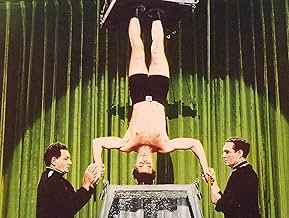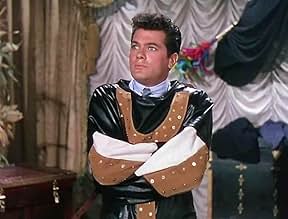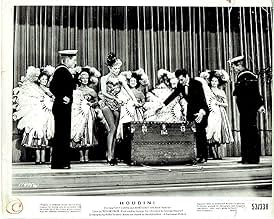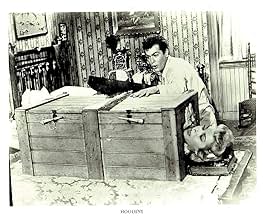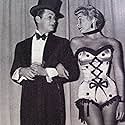VALUTAZIONE IMDb
6,8/10
3871
LA TUA VALUTAZIONE
Tony Curtis interpreta in modo coinvolgente il grande Houdini, circense in difficoltà che divenne il più accattivante illusionista ed escapologo del mondo.Tony Curtis interpreta in modo coinvolgente il grande Houdini, circense in difficoltà che divenne il più accattivante illusionista ed escapologo del mondo.Tony Curtis interpreta in modo coinvolgente il grande Houdini, circense in difficoltà che divenne il più accattivante illusionista ed escapologo del mondo.
- Regia
- Sceneggiatura
- Star
John Alban
- Restaurant Patron
- (non citato nei titoli originali)
John Albright
- Audience Member
- (non citato nei titoli originali)
Eric Alden
- Sailor
- (non citato nei titoli originali)
Fred Aldrich
- Bouncer
- (non citato nei titoli originali)
Elsie Ames
- Entertainer
- (non citato nei titoli originali)
Recensioni in evidenza
Spectacular biography of famed escape artist dealing with the Great Houdini. At the outset, he had little success he performed in dime sideshows, and even doubled as "The Wild Man .At the same the young Houdini (Tony Curtis) enters into a passionate affair with a beautiful girl. Harry met fellow performer Wilhelmina Beatrice (Bess) Rahner (Janet Leigh), whom he married. Bess acts in the shows , which became known as "The Houdinis." For the rest of Houdini's performing career, Bess would work as his stage assistant. During Harry Houdini's tour of Britain in 1926, the master escapist realizes a highly publicized show. Within months, he was performing at the top vaudeville houses in the country. In 1900, his manager arranged for Houdini to tour Europe. After some days of unsuccessful interviews in London, Houdini managed to interest a manager of the Alhambra Theatre. He gave a demonstration of escape from handcuffs at Scotland Yard, and succeeded in baffling the police so effectively that he was booked at the show.
It's a story with Harry Houdini, arguably the greatest illusionist and escape artist of our time. This is a mostly fictionalized biopic of Houdini's life, was made. It contains thrills, suspense , emotions, a romantic story and is quite entertaining . This film, well played by Tony Curtis and Janet Leigh, has contributed, in part, to several misconceptions about Houdini's life. For example, it portrays the cause of Houdini's death to be the magician's failure to escape from the Chinese Water Torture Cell. (Curtis's Houdini agrees to seek medical attention "when the tour is over.") Houdini actually developed the Chinese Torture Cell trick fourteen years before he died and performed it numerous times. The motion picture is finely directed by Geoorge Marshall.
The picture is partially based on facts , the real events were the following : Houdini's "big break" came in 1899 when he met manager Martin Beck in rural Woodstock, Illinois. Impressed by Houdini's handcuffs act, Beck advised him to concentrate on escape acts and booked him on the Orpheum vaudeville circuit. Within months, he was performing at the top vaudeville houses in the country. In 1900, Beck arranged for Houdini to tour Europe. After some days of unsuccessful interviews in London, Houdini managed to interest Dundas Slater, then manager of the Alhambra Theatre. He gave a demonstration of escape from handcuffs at Scotland Yard, and succeeded in baffling the police so effectively that he was booked at the Alhambra for six months.Houdini became widely known as "The Handcuff King." He toured England, Scotland, the Netherlands, Germany, France, and Russia. In each city, Houdini would challenge local police to restrain him with shackles and lock him in their jails. In many of these challenge escapes, Houdini would first be stripped nude and searched. In Moscow, Houdini escaped from a Siberian prison transport van. Houdini claimed that, had he been unable to free himself, he would have had to travel to Siberia, where the only key was kept. In Cologne, he sued a police officer, who alleged that he made his escapes via bribery. Houdini won the case when he opened the judge's safe (he would later say the judge had forgotten to lock it). He would free himself from jails, handcuffs, chains, ropes, and straitjackets, often while hanging from a rope in plain sight of street audiences. Because of imitators, on January 25, 1908, Houdini put his "handcuff act" behind him and began escaping from a locked, water-filled milk can. The possibility of failure and death thrilled his audiences. Houdini also expanded repertoire with his escape challenge act, in which he invited the public to devise contraptions to hold him. Brewers challenged Houdini to escape from a barrel after they filled it with beer in Scranton, PA and other cities. Many of these challenges were prearranged with local merchants in what is certainly one of the first uses of mass tie-in marketing. Rather than promote the idea that he was assisted by spirits, as did the Davenport Brothers and others, Houdini's advertisements showed him making his escapes via dematerializing, although Houdini himself never claimed to have supernatural powers.Poster promoting Houdini taking up the challenge of escaping an "extra strong and large traveling basket" . In 1912, Houdini introduced perhaps his most famous act, the Chinese Water Torture Cell, in which he was suspended upside-down in a locked glass-and-steel cabinet full to overflowing with water. The act required that Houdini hold his breath for more than three minutes. Houdini performed the escape for the rest of his career. Despite two Hollywood movies depicting Houdini dying in the Torture Cell, the act had nothing to do with his death. Throughout his career, Houdini explained some of his tricks in books written for the magic brotherhood. In Handcuff Secrets (1909), he revealed how many locks and handcuffs could be opened with properly applied force, others with shoestring. Other times, he carried concealed lockpicks or keys, being able to regurgitate small keys at will. When tied down in ropes or straitjackets, he gained wiggle room by enlarging his shoulders and chest, moving his arms slightly away from his body, and then dislocating his shoulders.For most of his career, Houdini was a headline act in vaudeville. For many years, he was the highest-paid performer in American vaudeville. One of Houdini's most notable non-escape stage illusions was performed at New York's Hippodrome Theater, when he vanished a full-grown elephant (with its trainer) from the stage, beneath which was a swimming pool. In the final years of his life (1925/26), Houdini launched his own full-evening show, which he billed as "3 Shows in One: Magic, Escapes, and Fraud Mediums Exposed".
It's a story with Harry Houdini, arguably the greatest illusionist and escape artist of our time. This is a mostly fictionalized biopic of Houdini's life, was made. It contains thrills, suspense , emotions, a romantic story and is quite entertaining . This film, well played by Tony Curtis and Janet Leigh, has contributed, in part, to several misconceptions about Houdini's life. For example, it portrays the cause of Houdini's death to be the magician's failure to escape from the Chinese Water Torture Cell. (Curtis's Houdini agrees to seek medical attention "when the tour is over.") Houdini actually developed the Chinese Torture Cell trick fourteen years before he died and performed it numerous times. The motion picture is finely directed by Geoorge Marshall.
The picture is partially based on facts , the real events were the following : Houdini's "big break" came in 1899 when he met manager Martin Beck in rural Woodstock, Illinois. Impressed by Houdini's handcuffs act, Beck advised him to concentrate on escape acts and booked him on the Orpheum vaudeville circuit. Within months, he was performing at the top vaudeville houses in the country. In 1900, Beck arranged for Houdini to tour Europe. After some days of unsuccessful interviews in London, Houdini managed to interest Dundas Slater, then manager of the Alhambra Theatre. He gave a demonstration of escape from handcuffs at Scotland Yard, and succeeded in baffling the police so effectively that he was booked at the Alhambra for six months.Houdini became widely known as "The Handcuff King." He toured England, Scotland, the Netherlands, Germany, France, and Russia. In each city, Houdini would challenge local police to restrain him with shackles and lock him in their jails. In many of these challenge escapes, Houdini would first be stripped nude and searched. In Moscow, Houdini escaped from a Siberian prison transport van. Houdini claimed that, had he been unable to free himself, he would have had to travel to Siberia, where the only key was kept. In Cologne, he sued a police officer, who alleged that he made his escapes via bribery. Houdini won the case when he opened the judge's safe (he would later say the judge had forgotten to lock it). He would free himself from jails, handcuffs, chains, ropes, and straitjackets, often while hanging from a rope in plain sight of street audiences. Because of imitators, on January 25, 1908, Houdini put his "handcuff act" behind him and began escaping from a locked, water-filled milk can. The possibility of failure and death thrilled his audiences. Houdini also expanded repertoire with his escape challenge act, in which he invited the public to devise contraptions to hold him. Brewers challenged Houdini to escape from a barrel after they filled it with beer in Scranton, PA and other cities. Many of these challenges were prearranged with local merchants in what is certainly one of the first uses of mass tie-in marketing. Rather than promote the idea that he was assisted by spirits, as did the Davenport Brothers and others, Houdini's advertisements showed him making his escapes via dematerializing, although Houdini himself never claimed to have supernatural powers.Poster promoting Houdini taking up the challenge of escaping an "extra strong and large traveling basket" . In 1912, Houdini introduced perhaps his most famous act, the Chinese Water Torture Cell, in which he was suspended upside-down in a locked glass-and-steel cabinet full to overflowing with water. The act required that Houdini hold his breath for more than three minutes. Houdini performed the escape for the rest of his career. Despite two Hollywood movies depicting Houdini dying in the Torture Cell, the act had nothing to do with his death. Throughout his career, Houdini explained some of his tricks in books written for the magic brotherhood. In Handcuff Secrets (1909), he revealed how many locks and handcuffs could be opened with properly applied force, others with shoestring. Other times, he carried concealed lockpicks or keys, being able to regurgitate small keys at will. When tied down in ropes or straitjackets, he gained wiggle room by enlarging his shoulders and chest, moving his arms slightly away from his body, and then dislocating his shoulders.For most of his career, Houdini was a headline act in vaudeville. For many years, he was the highest-paid performer in American vaudeville. One of Houdini's most notable non-escape stage illusions was performed at New York's Hippodrome Theater, when he vanished a full-grown elephant (with its trainer) from the stage, beneath which was a swimming pool. In the final years of his life (1925/26), Houdini launched his own full-evening show, which he billed as "3 Shows in One: Magic, Escapes, and Fraud Mediums Exposed".
By the early 1900s, the extraordinary Houdini earned an international reputation for his theatrical tricks and daring feats of extrication from shackles, ropes, handcuffs, and Scotland Yard's jails...
The film depicts Houdini's memorable escape from any pair of handcuffs produced by the audience; the outdoor exhibition, when he allows himself to be hanged upside down from his ankles, suspended from the roof of a high building, in a strait jacket; and, the dramatic act, when he accepts to be shackled with irons and placed in a box that is locked, roped, and submerged in frozen waters...
The film also exposes Houdini's campaign against mind readers, fraudulent mediums and others who claim supernatural powers... Houdini shows a passionate talent for escapology and the film did much to create the 'Water Torture Cell' illusion...
With his pretty-boy looks, Tony Curtis handles the title role with passionate skill... His energetic performance, as the talented and motivated magician, is very good...
With good period atmosphere, but with more attention to romance than to interesting detail, the film is quite enjoyable and colorful...
Janet Leigh does a great job as Houdini's faithful wife...
The film depicts Houdini's memorable escape from any pair of handcuffs produced by the audience; the outdoor exhibition, when he allows himself to be hanged upside down from his ankles, suspended from the roof of a high building, in a strait jacket; and, the dramatic act, when he accepts to be shackled with irons and placed in a box that is locked, roped, and submerged in frozen waters...
The film also exposes Houdini's campaign against mind readers, fraudulent mediums and others who claim supernatural powers... Houdini shows a passionate talent for escapology and the film did much to create the 'Water Torture Cell' illusion...
With his pretty-boy looks, Tony Curtis handles the title role with passionate skill... His energetic performance, as the talented and motivated magician, is very good...
With good period atmosphere, but with more attention to romance than to interesting detail, the film is quite enjoyable and colorful...
Janet Leigh does a great job as Houdini's faithful wife...
Tony Curtis is almost always good in whomever he plays, and he was fascinating in here as the famous magician "Harry Houdini." Curtis had a number of good roles in his prime. Speaking of "prime," Janet Leigh didn't look too bad in her prime, either: a very pretty lady.
I don't know how accurate this biography was, but I do know that this movie should have been longer. I usually say the opposite about films, but in this case, I would like to have seen more details about his life and death. His failure to communicate with dead - Houdini's misguided belief - wasn't discussed much.
I guess there were a couple of more modern-day films on Houdini, but they must not have been anything much since I never heard about them. Too bad, because a good re-make of this movie might be something to see.
I don't know how accurate this biography was, but I do know that this movie should have been longer. I usually say the opposite about films, but in this case, I would like to have seen more details about his life and death. His failure to communicate with dead - Houdini's misguided belief - wasn't discussed much.
I guess there were a couple of more modern-day films on Houdini, but they must not have been anything much since I never heard about them. Too bad, because a good re-make of this movie might be something to see.
Even over 80 years after his demise the name Houdini is still the standard by which magicians of all kinds are measured. David Copperfield, Rick Blaine, these guys are nothing in terms of popularity that Harry Houdini earned. The tricks he did are still being performed or attempted by magicians who want to make a name for themselves.
Paramount obtained the rights to the Houdini story from the estate of Harry Houdini from the guy his widow Bess gave it to after she died in 1943. They shelled out some big money at the time to obtain loan out services for Tony Curtis from Universal and Janet Leigh from MGM. The two of them had gotten married the year before and as a couple were getting a lot of publicity as young Hollywood marrieds. Houdini turned out to be the first of five films they did together, six if you count the joint appearance they did in the all star Pepe.
Back then, young and in love, Tony and Janet function beautifully as a team as Harry Houdini and his beloved wife Bess. Angela Clarke plays Houdini's mother who was also important in his life. What's not shown is the tension between the two women, they were not friendly. But that's one of several inaccuracies.
In fact this biographical film is mostly a work of fiction. But it's pleasant enough entertainment and it was the first film that Tony Curtis starred in that could be considered an A production. In his memoirs he recalls the experience as a pleasant one because of Janet and director George Marshall who he says was a good man to work with and an under-appreciated talent.
One thing that is shown is Houdini's interest in the occult after the death of his mother in 1920. He did in fact go around debunking fakers in the field which is field that is saturated with them. One thing not in the film is the fact he came into conflict with Sir Arthur Conan Doyle, creator of Sherlock Holmes, and fervent believer in the reachable spirit world. That in itself would make an interesting film.
I'm sure if Harry Houdini were able to comment he'd probably say he liked the film. He'd have to wait for a more accurate film about his life in the Eighties from Paul Michael Glaser and Sally Struthers. But I'd be flattered all to heck to think Tony Curtis was my type.
Paramount obtained the rights to the Houdini story from the estate of Harry Houdini from the guy his widow Bess gave it to after she died in 1943. They shelled out some big money at the time to obtain loan out services for Tony Curtis from Universal and Janet Leigh from MGM. The two of them had gotten married the year before and as a couple were getting a lot of publicity as young Hollywood marrieds. Houdini turned out to be the first of five films they did together, six if you count the joint appearance they did in the all star Pepe.
Back then, young and in love, Tony and Janet function beautifully as a team as Harry Houdini and his beloved wife Bess. Angela Clarke plays Houdini's mother who was also important in his life. What's not shown is the tension between the two women, they were not friendly. But that's one of several inaccuracies.
In fact this biographical film is mostly a work of fiction. But it's pleasant enough entertainment and it was the first film that Tony Curtis starred in that could be considered an A production. In his memoirs he recalls the experience as a pleasant one because of Janet and director George Marshall who he says was a good man to work with and an under-appreciated talent.
One thing that is shown is Houdini's interest in the occult after the death of his mother in 1920. He did in fact go around debunking fakers in the field which is field that is saturated with them. One thing not in the film is the fact he came into conflict with Sir Arthur Conan Doyle, creator of Sherlock Holmes, and fervent believer in the reachable spirit world. That in itself would make an interesting film.
I'm sure if Harry Houdini were able to comment he'd probably say he liked the film. He'd have to wait for a more accurate film about his life in the Eighties from Paul Michael Glaser and Sally Struthers. But I'd be flattered all to heck to think Tony Curtis was my type.
This film is a very enjoyable if not completely accurate rendition of Harry Houdini's life. Tony Curtis and Janet Leigh, young and in love in real life, do a great job of playing Harry and Bess Houdini. An amateur magician himself, Curtis gives a great performance in the first really good role of his career. There will be many to come. What's accurate about this film? Most of the escapes shown in the film such as when Houdini allowed himself to be hung upside down outside of a tall building while confined in a strait jacket, his offering and succeeding to escape from any pair of handcuffs that his audiences could produce, and his decision to go through with being locked in a box submerged in water while he himself is bound in chains.
What's inaccurate in the film? It's more a matter of what is omitted. The film does mention Houdini's running battle with spiritualists. What it doesn't mention is Houdini's tiff with Sir Arthur Conan Doyle over the whole issue. The depth and length of this disagreement is considerable, though, and it's understandable that in a film not of documentary length that it had to be left out.
It makes a good double bill with the1976 made-for-TV film "The Great Houdini" with Paul Michael Glaser in the title role. That 70's version of Houdini's life gives more details about what made the man tick, even if there is something about its atmosphere that transports one back to the days of disco.
What's inaccurate in the film? It's more a matter of what is omitted. The film does mention Houdini's running battle with spiritualists. What it doesn't mention is Houdini's tiff with Sir Arthur Conan Doyle over the whole issue. The depth and length of this disagreement is considerable, though, and it's understandable that in a film not of documentary length that it had to be left out.
It makes a good double bill with the1976 made-for-TV film "The Great Houdini" with Paul Michael Glaser in the title role. That 70's version of Houdini's life gives more details about what made the man tick, even if there is something about its atmosphere that transports one back to the days of disco.
Lo sapevi?
- QuizA talented amateur magician, Tony Curtis performed most of his own tricks in this film.
- BlooperWhen the Houdinis and the reporter are being driven to the séance, the same rear projection loop is continually run in the car's back window, repeatedly showing the same background traffic, with the splice where the loop begins plainly visible each time.
- Citazioni
Harry Houdini: I hadn't prepared anything for tonight, but perhaps I have something that will amuse you. So if you'll get a couple of broomsticks, I'll get my wife - and we'll see what we can do.
- ConnessioniEdited into Magic with the Stars (1982)
- Colonne sonorePerpetuum Mobile, Op. 257 (Perpetual Motion)
(uncredited)
Music by Johann Strauss
Played during the straitjacket contest
I più visti
Accedi per valutare e creare un elenco di titoli salvati per ottenere consigli personalizzati
- How long is Houdini?Powered by Alexa
Dettagli
- Data di uscita
- Paese di origine
- Lingua
- Celebre anche come
- Houdini
- Luoghi delle riprese
- Azienda produttrice
- Vedi altri crediti dell’azienda su IMDbPro
- Tempo di esecuzione1 ora 46 minuti
- Colore
- Proporzioni
- 1.37 : 1
Contribuisci a questa pagina
Suggerisci una modifica o aggiungi i contenuti mancanti

Divario superiore
By what name was Il mago Houdini (1953) officially released in India in English?
Rispondi

